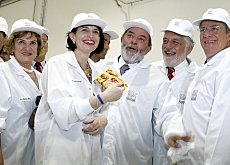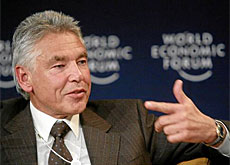Brabeck explains how Nestlé delivers the goods

As the world's number one food company, Nestlé, looks back on a record result in 2006, its CEO and chairman Peter Brabeck tells swissinfo how it is achieved.
Net profit at the company, which is based in Vevey on Lake Geneva, rose by 13.8 per cent compared with 2005 to a record SFr9.2 billion ($7.4 billion). Sales are hovering just below the SFr100 billion mark.
Nestlé said the result had been boosted by its food and beverages businesses and added that it expected the company’s growth path to continue in 2007.
Brabeck, who confirmed he will step down as CEO in 2008, explains how Nestlé consistently achieves its target of annual organic growth of between five and six per cent.
Known as the Nestlé model, the target has been achieved for the past 11 years in a row.
And if Brabeck has his way, the company will continue to deliver the goods in the foreseeable future.
swissinfo: The Nestlé business model is to grow every year between five and six per cent. That means with your present turnover by about SFr7 billion ($5.64 billion) this year. How do you manage to achieve that?
Peter Brabeck: (laughs) By listening very, very carefully to all the consumers wherever they are. It is the consumers who tell us what they need and what they want. You have some fundamentals that are very important and which assure that this model will still be valid for the years to come.
One is demographics. The trend today is that we have an ageing population and a strong urbanisation, and an urbanised population needs to have industrial nutrition otherwise they wouldn’t be able to survive. This also brings a certain improvement of their living standard. Normally the first industrial products that they come in contact with is a food product, so we have launched an initiative which we call Popularly Positioned Products which really allows us to make contact with our consumers very, very early on, and then afterwards to accompany him or her with his increasing living standards.
swissinfo: Nestlé is moving to become a nutrition, wellness and health group. What is the strategy behind that?
P.B.: Consumers all over the world start recognising that nutrition has an impact on their health. Unfortunately today we are talking more about the negative impact, which is called obesity. That comes from an unbalanced diet but the consumer also understands that where there is a negative there is also a positive. That means that if you have a balanced diet, if you have good nutrition, this will have a positive impact on your health and your longevity.
swissinfo: You are trying to strengthen nutrition in particular. Who are you aiming at? Who are your customers?
P.B.: The customers are our normal customers. I’m not aiming against any competitors because frankly speaking we are in the leading position. We invented this some years ago before anybody was talking about it. It is just the adaptation of the group to the ever-changing demands of consumers.
swissinfo: You’ve often talked about the strategic importance of brands for Nestlé, with many of them having annual sales of SFr1 billion. Just how important are they?
P.B.: We now have 25 brands that each sells more than SFr1 billion. It’s the club of the billionaires as we say and this is of course extremely important for a fast-moving consumer goods company. This tells you about the strength of the stable of brands you have.
We are today doing 70 per cent of our business from those billion franc brands. They give you marketing efficiency; they give you the familiarity between the consumers and the brands. Brands continue to be one of the most important issues for the success of our company.
swissinfo: You’ve often said that innovation is key in this group. Does that concern only products?
P.B.: No, it concerns everything – the way we are running this company. If you think about our project GLOBE, which stands for Global Business Excellence, this was and still is a huge innovation. There is no other food company or other fast-moving consumer goods company that has implemented such a system. The way we are running the company today is completely different than the way we were running it in the past, so innovation and renovation are something not only for the product. It’s for every aspect of the company.
swissinfo: Can you give us an idea of the outlook for the coming years at Nestlé?
P.B.: We have delivered for the 11th consecutive time in 2006 the Nestlé model. Believe me, I want in 2007 that we deliver the Nestlé model for the 12th consecutive year. This year is special to me, so we’ll do everything to deliver this model again. I announced last year that at the shareholders’ meeting of 2008 I would step down as CEO and stay in the position of chairman. 2007 is going to be my last year as CEO of Nestlé and therefore I want to be sure it’s a great year for the company.
swissinfo-interview: Robert Brookes in Vevey
Nestlé 2006 figures:
Sales: SFr98.458 billion (+8.1% compared with 2005)
Operating profit: SFr13.301 billion (+12%)
Net profit: SFr9.197 billion
Organic growth: 6.2%
Proposed dividend per share: SFr10.40 (+15.6%)
The company manufactures around 10,000 different products and employs about 250,000 people.
The company made strategic acquisitions in nutrition, health and wellness.
They included Uncle Tobys, Jenny Craig and Novartis Medical Nutrition.
It disposed of under performers with total annual sales of more than SFr2 billion. They include Chilled Dairy Europe, making bottles for Perrier water and liquid milk businesses in Thailand, Malaysia, Singapore and Brunei.

In compliance with the JTI standards
More: SWI swissinfo.ch certified by the Journalism Trust Initiative











You can find an overview of ongoing debates with our journalists here . Please join us!
If you want to start a conversation about a topic raised in this article or want to report factual errors, email us at english@swissinfo.ch.